Peru has been a country of extreme highs and lows. From the peaks of the Andes to the tides of the Pacific ocean, via bus and by plane. From fevers and toilet bowls to summiting mountains, running and body surfing.
We occupied our waking hours in transit from La Paz to Cuzco essentially downloading the local knowledge and recommendations about Ecuador from two young Ecuadorian guys sitting across from us.
Somewhere back in Bolivia, Cienna and I had started a sick joke version of the infantile game slug bug called llama drama. In this version we would punch the other in the arm any time we saw llamas. Live llamas are a common sight in Bolivia and even more common in Peru, but the most common sight of all is tourists strolling down the street in llama sweaters, gloves, scarves or other prancing llama apparell. When we got off our bus shortly outside Copacabana to show our papers and cross the border into Peru, we did so in droves. Standing there in twilight waiting to reboard the buses, the llama sightings and arm bruising rose to ridiculous levels. So ridiculous, in fact, that we agreed to give the game a rest.
Getting off the bus in Cuzco at 5:30 in the morning in the freezing cold, pouring rain was a shock to the system. I was glad I had gotten cold a few hours earlier, extracted my rain gear from my pack and put it on as an extra layer. Through the grog and the rain, I negotiated an overpriced cab fare and we and our bags piled in. The driver piloted us down dark, slick, cobbled streets, inquiring a few times where exactly we wanted to be dropped. I answered as best I could. The trouble (besides the lack of caffeine) was that I didn’t know exactly.
I was operating off a más-o-menos set of instructions from Youjia for a hostel in the San Blas neighborhood. The cab driver left us in a shut up, dead-quiet, cobbled street with yellow lamplight and rivulets of rainwater streaming around us. We hoisted our stuff on our backs and headed up a narrower cobbled street to the right where cars aren’t allowed in search of the correct address, to no avail. We turned and tried the other direction, doubling back to make a small loop, feeling more drenched and less hopeful by the minute. Eventually, we gave up on the originally recommended lodging, and stumbled into the only place we could find open, mid-block in an alley called Ladrillo, through a beat up doorframe and a concrete courtyard.
The initial plan was to only stay in this hospedaje one night, long enough to deposit our stuff and go, unburdened, in search of the originally recommended hostel. But, for various reasons, this first landing pad would be our place the entire week we stayed in Cuzco. It was servicable enough, if a little funny smelling. We slept a few hours, then went out exploring around Plaza de Armas and the San Blas neighborhood. We quickly found Jack’s, a café on a streetcorner a long block from where we “lived” where the coffee was strong, the scrambled eggs were abundant and the llama-sweater clad clientele was steady. We became regulars.
We arranged through a tour company to travel to Aguas Calientes by van and train later in the week, and the next day to Machu Picchu, Waiynapicchu and back to Cuzco. With those arrangements squared away, we wandered. Cienna had read about the Qorikancha church (now known as Santo Domingo), where Spanish Colonial architecture is layered over the top of Pre-existing Inca architecture and was eager to go. All were impressive architects, but when viewed side by side, the stonework of the Incas clearly surpasses the colonial stuff in its seamless sophistication.
That evening we made the fateful decision to eat a nicer meal at a highly recommended gourmet restaurant. Three out of four scallops we consumed there tasted delicious, but one of the two Cienna had tasted a little fishy, she now recalls. That little scallop went on to plague her with two solid days and nights of intensive food poisoning!
First she could barely even stomach the mint tea I brought her, but after a while she worked her energy and her nerve up and we ventured down the street to a restaurant that served simple but decent Peruvian food. (The decision in the wake of the scallop incident had been to patronize less expensive restaurants, since it generally seemed to be true that the “nicer” the meal, the greater the risk of getting sick.) Cienna ordered dieta de pollo (a simple chicken noodle soup) and I ordered anticucho (a traditional Peruvian dish of skewred beef heart served with boiled potatoes and corn on the side) plus a Cusqueña (Peruvian beer).
Both meals were delicious, but Cienna’s stomach rejected the input. I couldn’t help but laugh a little as the noodles and broth she’d just consumed were deposited onto the cobbled street and the rear wheel of a man’s car parked nearby. (This trip is teaching me how much laughter is an energy outlet and stress reliever for me.) “Laugh now, but your time is coming, Erica,” Cienna prophesized. I knew she was probably right, so I did my best to swallow my laughter.
The next day, her stomach accepted substantial food, finally. Walking around town now involved lots of little rests along the way, and we wondered how many rests we would need on the way up to Machu Picchu.
Friday morning came and we went to the plaza to meet the tour operator, who immediately forced me to use my Spanish and my bargaining skills by asking that we pay more than the agreed upon price. She quickly backed off however, when she could see I had a receipt and wasn’t budging. She piled us in a cab with herself and two guys from Spain, which meant me on Cienna’s lap. Next she piled us on a minibus that promised to take us to the train station in Ollantaytambo.
That all seemed to be going well enough until, about 45 minutes into the ride, the driver pulled over and got us all out of the vehicle, citing some mechanical failure. There was a ripple of first confusion and then discontent among the passengers. Another bus is coming, the driver tried to reassure, and you will make your train. Most of us recognized it as a hollow promise.
A group of hulking men from Brazil wearing Dakar hats and shirts had a heated exchange with the driver, who relented and boarded us all back on his minibus. In response to my request for more info, the driver merely shrugged, pointed to the Brazilian hulks and said (in Spanish), “They were in the Dakar, they know car mechanics, and they say we can keep going and fix it later.” (The Dakar is a four-wheeler race through the sand dunes of Bolivia’s salar, where we had coincidentally been a week before the 2014 race.) At that point, there was nothing to do but sit back and hope for the best.
We wound up and down hillsides, with the road periodically feeding us out into broad river valleys and through towns in the throes of tourist-driven development. On our way through one town, I started reflecting on the perpetual state of building and breakdown these towns seem to be in. It made me wonder which would come first: full blown development or the implosion of the capitalist systems around the world that fuel such development? Or maybe they all come together in one slug?
Sandwiched between two of the Brazilian hulks, I conversated with them as best I could given that their main language was Portuguese and mine English. They were exceedingly friendly. I also eavesdropped for quite a while on the two young men sitting directly behind me who were brimming with enthusiasm and rapid-fire Spanish banter. (Learning Spanish by way of immersion has turned me into a shameless – sometimes even proud – eavesdropper.) After some time of listening, I turned and began talking to them. I was certain that they were Chileans, and I was right.
At some point, when the conversation turned to what I do for a living, it came out that I work to protect the environment. That fact earned me new respect from the young Chileans, one of whom reached over to shake my hand when he heard this, as if I were some kind of celebrity. It was a boistrous rest of the ride, but while the minibus was struggling to accelerate up one hill, the driver finally insisted that we transfer to another minibus with more power to get us up hills. We arrived in Ollantaytambo with barely enough time to go to the bathroom, then boarded our train.
The view from the train was awe-inspiring, as we snaked our way through a canyon next to a rumbling, muddy river flanked by soaring green mountains on all sides. We were aware that we had switched fairly suddenly to a jungle setting, with vines hanging from trees, humid air and tropical flowers peeking from behind abundant vegetation. Arriving in Aguas Calientes, no one was there to pick us up as the tour operator had promised. We started asking around about how to find our hostel, and followed directions to the top of the hill. We left our stuff in our room and continued on to the aguas termales (hot springs), happily soaking in the three pools of varying temperatures. The mineral water in the springs there has a refreshing, almost cleansing quality to it.
After a pizza dinner, a few drinks and a game of Jenga at one of the MANY restaurants down the main street in town vying for our business, Cienna went to bed and I spent hours wrestling more info from our hostel about the specs of connecting with our tour the next day. Ultimately, the lesson of tours in South America, and particularly this one, is that just because you pay someone to do something and they say they will do it, don’t assume they will do it. From that point on, we gave up on our no-show guides and ran our own tour, which made for a better experience. But, the tour package did ultimately get us there and set us up with a decent place to stay, so I can’t complain too much.
The following day, our neighboring room occupants rose early and made about as much noise as possible. So, we got up and got going too. We walked alongside the leaping river downstream, crossed over a well-established bridge where buses roared over, and started up the switchbacking, stony trail to Machu Picchu. Our faces were instantly covered in a coating of pearly beads of sweat, which it was clearly pointless to wipe away. It took us a little over two hours of trudging up through these warm, wet mists to reach the ticket entrance to the ruins. We blamed the altitude for our slightly slower than expected ascent.
I was feeling pretty proud of getting there until we started up Waiynapicchu, the torturously steep mountain looming in the backdrop of your classic Machu Picchu picture. We had signed up to climb Waiynapicchu in the second group of visitors, in the late morning after the mist cleared. That climb was one of the physically more challenging things I have accomplished in some time. But to be up there amongst the clouds and the mountaintops with the river and the bulk of the ancient Inca ruins wrapping around us far below, vale la pena completamente (it was totally worth it!)
In fact, I found myself thinking back afterwards that Machu Picchu (and Waiynapicchu) is one of the few things I can think of in the world that lives up to and even exceeds all its hype. We were lucky enough to be there in the off season, when it is not overrun with tourists. I would recommend going to see this wonder of the world to anyone and everyone. One of the things Cienna and I were both struck by exploring around the place was the architectural choices made to sometimes hew a stone until it was completely smooth and a perfect fit with neighbors, while other times allowing large boulders and hunks of bedrock to retain their original forms, basically conceeding to work around them. The result is a fascinating mix of natural and heavily worked rock walls and stairs.
We descended, ravenous, and went in search of food and an espresso milkshake. A few delays later, at about 8:15 p.m. we boarded our train back to Ollantaytambo. In the dark we worked our way to the back of a line of minibuses, seeking the one that would take us back to Cuzco for 10 soles, the price we had paid on the way there. We found it and folded ourselves into the two remaining seats in the van. It was cramped, but I didn’t much care – all I wanted was to sleep. Cienna, however, was unable to sleep much because she had noticed that the driver kept slowing way down, and realized that he was repeatedly on the verge of falling asleep. It felt as though we had naively tempted fate, and won, in both directions.
Our intent was to make it to Pisac and the Sacred Valley in the next few days, but the airline gods thwarted those plans. After a reality check from the Ecuadorians on our bus ride from Bolivia to Peru about the distance we would need to cover between Cuzco and the coast of Peru (at least three days of bussing) we had resolved to fly. That didn’t turn out to be as easy as we had hoped, as you have to call to confirm airline tickets with Avianca Airlines, and phone calls from Peru can be a truly frustrating experience.
After days of attempting to straighten it all out on the phone, we finally just took a cab to the airport, thinking it would be easier to sort it all out in person. We were wrong. Hours later, we left with two purchased but still unconfirmed tickets. That afternoon, what we did that finally worked was walk into a very nice hotel on the corner of Plaza de Armas, promise to buy lunch and petition for help and use of a higher functioning phone line. A good half hour later, after numerous holds with the airline, we were confirmed at last. Who would have thought it would be so difficult to get someone to accept your money?
When we boarded our flight from Cuzco to Lima and then Lima to Trujillo the next day, we were giddy at how smooth and easy it all was. The air that greeted us in Trujillo was cool and salty like you would expect of a coastal town. Neither of us knew what to expect of Trujillo, a town with a reputation for good ceviche and knifepoint robberies. My experience of the place was overall very tranquilo and positive.
We stayed a few days in a quiet, comfortable hostel there a few blocks removed from the main pedestrian strip and the broad, lively plaza downtown. Strolling down the strip, we spotted a woman selling a wheelbarrow load of fava beans marinated in lime with salt, cilantro and chopped onion. We purchased two little bags of the beans and continued walking, happy for the tasty local shot of protein.
We walked outside the circular downtown area on a fruitless search for bus companies. On the way we stopped to ask a woman for directions and bought two cups of her fresh-squeezed juice of piña and naranja. All the directions we received were similar – somewhere in the vicinity of a town cemetery we’d find the bus companies. The cemetery was lined by a block of flower shops, tombstone vendors and other small businesses subsisting off of deaths. It seemed to be a thriving industry.
Cienna was coming down with a cold, so I went twice to the Olympic sized swimming pool nearby to break my body back into the idea of getting regular aerobic exercise. A few blocks past the pool was the bus station, and an unpretensious little cevichería called Chelita’s. It was a very productive venture out. I never would have expected to find an Olympic sized pool down here, and in little Trujillo no less. The sheer size of that kind of pool can be a little intimidating, but once you get into it, it’s liberating. And the cebiche was served by curious, young Peruvian waiters in citrusy heaps with sides of yucca and corn and laced with seaweed.
The following day, waiting for our night bus to Máncora, we took a micro to the beachier side of town to explore through a set of ruins called Chanchan. The mud walls adorned with designs of birds and fish and stylized fish net patterns had been undergoing restoration, so much of it was roped off. But a fresh sea breeze was blowing and it felt great to be out walking around. It was also nice to visit ruins with much less fanfare than Machu Picchu.
Our seats on the bus to Máncora were situated right behind the barrier to the stairs leading up to the second level of the bus. This meant less than normal leg room. By morning, when we pulled into our destination, we were stiff and groggy. Mototaxi drivers descended on us like the fresh meat that we were. I firmly asked for a moment and a little space while we discussed our plans. The third time I made the demand, accompanied by a reminder that there would be no money for them if they continued to press their luck, they backed off a bit. Then we contracted one to llevar (carry) us to cabañas on a hill overlooking the little surf town. Cienna posted guard with our stuff while I went up the dusty, switchbacking trail to investigate. No espacio disponible (available space). Just as well because the idea of hiking up that with bags and no coffee in my system had been pretty off putting.
We started back down the dirt road toward town, and rented a room in the first place we saw on the main drag. It was a real hole in the wall, and swarming with mosquitos, but it served its purpose for the time being, basically a baggage repository. We could survive here for a night until better accomodations could be found. We left looking for food and caffeine, settling on a clean enough looking place called Regina’s. It was a family owned joint, and the family of owners turned out to be muy amable (very nice people.) We told the man serving us breakfast that we were seeking a place with a kitchen we could access. He recommended a place on a side street en route to the beach.
We set out in search of it after decent cups of coffee and a crepe stuffed with tropical fruits, which we split. (Note splitting food turns out to be the way to go while traveling, we’re finding.) On the way down the dirt street, we passed mototaxis bumping along, a swampy area on the left and the recommended hostel on the right. Its tall metal gate was closed, with no bell in sight to ring. We shrugged and kept heading for the beach. About a block shy of the sand and waves, we noticed a simple, understated sign advertising Laguna Surf Camp and Pepe’s restaurant.
The bamboo gates were open, and the owner Pilar (a surf instructor in her spare time) was standing near the neat, thatched reception area. We inquired about space and price. There was space, and we instantly had a good feeling about the place. Pilar’s large, slinky dogs, Ron and Luna, lounged in the yard. Hammocks hung everywhere. A little swimming pool shaped like a jelly bean anchored the yard, ringed with bungalow style rooms, each with their own roomy patio.
As we walked back to our hole-in-the-wall hostel, Cienna and I discussed our options. After that last hostel in Cuzco with the smelly bathroom drain, we both felt ready for and deserving of an upgrade. We decided to think of the 30 soles paid for our hole-in-the-wall room as a mood tax, forfeit that price and move immediately to Laguna. It was a decision which validated itself instantly. Our room and bathroom were spacious and clean, and we had easy access to the beach only restricted by high tides. What’s more, we soon found that Pepe’s restaurant served unbelievably good shrimp salads, chicken sandwiches, strawberry shakes, fruit yogurt granola bowls and maracuya (passion fruit) sours. (Whereas in Bolivia I made it my goal to try quinua in as many forms as possible, here in Peru it would be Maracuya.)
As is becoming characteristic of the day after long bus rides, we fell instantly asleep and slept hours through the middle of the day. When we forced ourselves up, we sunscreened thoroughly and went directly to the beach to play in the waves. Apparently, we arrived in Máncora for the last week of surfable waves.
I was instantly reminded of my preference for freshwater over saltwater. Growing up on the Salmon River, I grew accustomed to opening my eyes under water, and that became a habit nearly impossible to break that I pay dearly for in the ocean. Even when I do squeeze my eyes shut, my eyes still become extremely irritated by the salt. What’s more, I had forgotten about the gritty reality of being pounded into the sand by the surf. But I rapidly recalled how to judge whether to dive over or under the waves depending on your space-time relationship to the breaks and then it became more fun. Still, the waves were pushier than I would have liked, pulling us continually north, so I didn’t stay in long that first day. Cienna, on the other hand, was a happy clam. She had been angling for a beach vacation since months before she quit her job at The Stanger. We ran down the beach to the south, taking advantage of the soft landing and muscle building properties that sand affords. We went through tubes of sunscreen. We explored the dusty, exposed main street in both directions, veering off course to the north into poorer neighborhoods. Sunset slanted toward us as we encountered a young women’s volleyball game blocking of the sandy street.
A few days into our time there, while we dealt out another game of Casino upstairs waiting for our food, Pepe suggested fun things to do in the area. The most captivating suggestion was swimming with turtles. That night we went to a beachfront bar on the tourist strip closer to the south end of the beach, primarily because it had a large television and the bartender had promised us that we could watch the Superbowl there. We plunked down next to one other Superbowl watcher from San Diego. Cienna was still feeling under the weather, so she left at halftime.
That turned out to be a wise move, not only because it was such a lopsided win for the Seahawks, but also because my time with sickness was indeed coming. Staying up late at a bar consuming Piña Coladas was just the opening Cienna’s sickness needed to ambush my system.
The next morning, my throat was sore and my head was dizzy, so we decided to punt the turtle swimming expedition. Cienna had a fever. (The cockroach in our shower when we returned from the Superbowl watching was gone, presumably a nice crunchy midnight snack for the lizard that had also made a few appearances in our bathroom.)
On my last relatively ok feeling day, I went to the pharmacy and did my best to explain our symptoms in Spanish to the pharmacist. She prescribed an expectorant for the cold-like symptoms and an anti-gripe (anti-flu) medication to reduce the fever. On my way home I picked up a pizza and stopped in at Regina’s, where they had agreed to let me use their kitchen and ingredients to make a batch of lime-honey-garlic tea in Cienna’s insulated canteen (which still smells and tastes of garlic!) Once again, I made more than I needed and shared a cup with the restaurant owners, leading to an interesting exchange over a cutting board, a pot of boiling water, and a cup of strange tea.
After that night, we must have slept for about three days straight in hopes that our fevers would recede. After a while it was difficult to tell if I was sweating from the fever or the humidity in Máncora. On the fourth day, I switched from Peruvian anti-gripes to extra-strength Ibuprofen and concluded that the Ibuprofen were much more effective. I woke in the middle of the third night with intensely uncomfortable diarrhea and nausea. Fortunately, it passed quickly and by the fourth day, food wasn’t yet appealing to me, but coffee tasted good again finally. I managed to choke down half a chicken sandwich, and the world suddenly seemed more hospitable again.
We were scheduled to depart that night on a bus for Cuenca in Ecuador, but in our post-sicky state, we decided it was not feasible. Extension of our stay in Máncora turned out to be for the best, not only because we had more time to recuperate in a seashore setting, but also because we were at last able to seize the opportunity to swim with sea turtles.
We borrowed a mask and snorkel, followed Pepe’s instructions and took a 20 minute bus ride south and then a 15 minute mototaxi even further south to Ñuro, where Pacific Greeen turtles glide around a large pier. We didn’t get it together to go until about 3 in the afternoon, so we got there close to 4. That also turned out to be a good thing. Besides the turtles, our company was a handful of Peruvian fishermen and a few mischievous Peruvian kids. Floating above or alongside the turtles, from babies to crusty ancianos (elders), surfacing and diving, drifting with the deep, light pierced blue waves with a tinge of green, gives you a timeless, undulating feeling. Under the pier, large silvery schools of little fish envelope you, flashing first one way and then the other. Nothing short of magical.
It is apparently a prime place for sea-turtle research and conservation. Surprisingly, there are still significant parts of a turtle’s life that are unknown to humans. This little known life stage for sea turtles is referred to as the lost years.
Maybe looking back, these will be my lost years? Or maybe my found years. In any case, Ecuador, by bus in the middle of the night, is next.



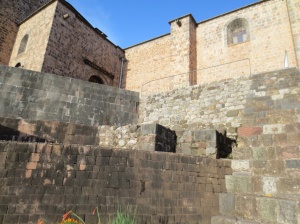

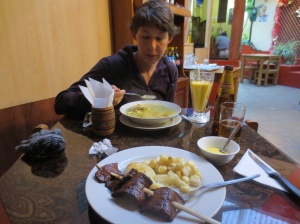









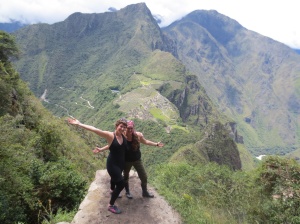








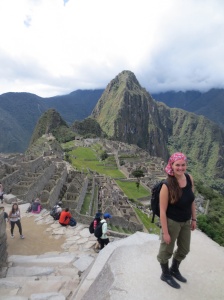










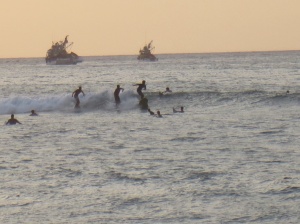



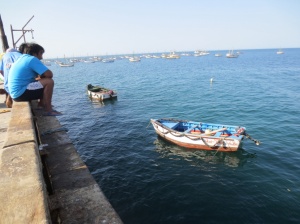


Wonderful stuff. Esp the breakfast photos and the great photo gallery generally.
Ford
Estamos celosos, muy celosos. The Machu Pichu pics look awesome, and your food and travel games bring back so many wonderful memories. Where are you going to be in June, July and August? We’ll be in north eastern Brasil. Peace – Fillingim-Selks
Huge favor, if you are headed to Otavalo; I would absolutely adore seeing a picture of the building that housed Miche and my restaurant in the suburbs of Otavalo back in 1973. When we rented it, it was being used mostly as a grain silo. I’ve checked with Michele and she’s as at a loss for its exact location as I am.
I do remember an old geo/topographical map listing the house as “Villa Rocio” in the “Barrio Cardon”. As I recall we obtained that beautiful old topo map at Instituto Geográfico Militar (IGM) at Venezuela 573 and Sucre (by the Casa Museo de Sucre, old town) or Senierges and Patel y Miño (above Parque El Ejido). Even if you can’t pursue finding the restaurant (very doubtful it’s still a restaurant) you might want to check out the map resources at the IGM. Hiking around Otavalo is spectacular, especially with old maps.